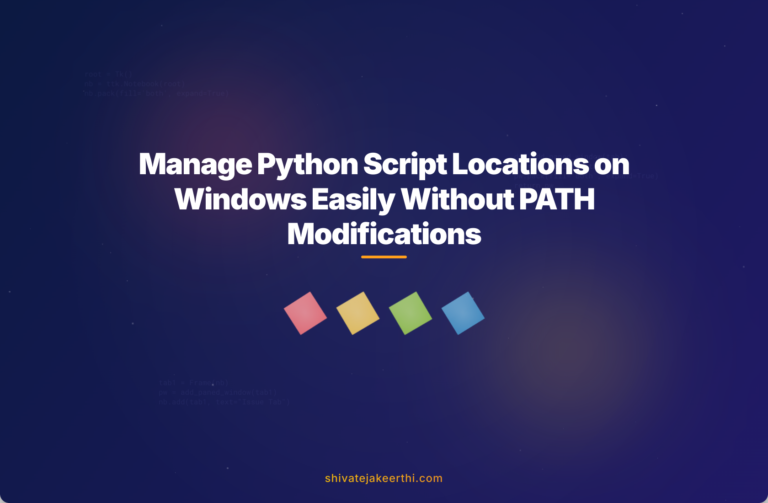When working with Python scripts on Windows, one frequent challenge is finding the script installation folder, especially when you prefer not adding folders to your PATH environment variable. This often creates confusion, particularly when Python versions change regularly and batch scripts break due to hardcoded locations. Thankfully, there’s a practical solution that doesn’t involve altering your system PATH. Let’s explore how.
Installing Python 3.13 on Windows 11
To get started, installing Python 3.13 on Windows 11 can be quick and simple using winget, Microsoft’s official package manager.
Open Windows Terminal or Command Prompt, then use this command to install Python:
winget install pythonOnce Python 3.13 installs, you might want pip, Python’s package installer, if it isn’t pre-installed. Even though modern Python versions often bundle pip, here’s how to ensure it’s installed:
python -m ensurepip --upgradeWhen you execute ensurepip, pip is installed in a specific directory, typically at:
%APPDATA%\Python\Python313\site-packagesYou might need this information later, especially if you prefer knowing the exact locations of installed packages without modifying environment variables.
Running pip Safely from Command Prompt
Most tutorials suggest running pip commands directly from the command line by typing pip install package-name, but there’s an even better way. You can run pip through Python itself by executing:
python -m pip install package-nameUsing python -m pip is safer and more reliable, as it ensures pip runs using the same Python interpreter you’re currently invoking. This method avoids potential conflicts if multiple Python versions exist on your machine.
Locating the Python Scripts Folder
Whenever you install Python packages that contain executable scripts, these scripts reside in a designated Scripts directory. Typically, this is found at:
%APPDATA%\Python\Python313\ScriptsUnderstanding where scripts reside is crucial if you’d prefer not to update your PATH environment variable. Accessing this directory manually through File Explorer or via command line will confirm installed executables like pyinstaller, django-admin, or others exist in this Scripts folder.
Challenges Associated with the Python Scripts Folder
Interestingly, even though Python sets up this Scripts folder automatically, it doesn’t automatically add the folder to your system’s PATH variable. This omission means command-line access directly to these scripts isn’t immediately possible.
Additionally, Python versions change regularly, meaning the installed script paths shift accordingly. For instance, switching from Python 3.12 to Python 3.13 would change your Scripts path from %APPDATA%\Python\Python312\Scripts to …\Python313\Scripts, breaking any manually coded batch scripts that rely on fixed paths. Constantly updating such scripts becomes inconvenient and error-prone.
Exploring Python’s USER_BASE and USER_SITE
There’s a hidden gem built into Python which helps us overcome PATH limitations: the Python standard library module called site. Python’s built-in site.USER_BASE and site.USER_SITE variables hold vital clues.
If you run Python and execute these commands, you’ll reveal the specific location Python recognizes for user-installed packages and scripts:
python -c "import site; print(site.USER_BASE)"This outputs something like:
C:\Users\YourUsername\AppData\Roaming\PythonSimilarly, to discover the exact location of USER_SITE packages directory:
python -c "import site; print(site.USER_SITE)"This typically reveals:
C:\Users\YourUsername\AppData\Roaming\Python\Python313\site-packagesThis information helps clarify the exact folder paths utilized by Python without guessing or assuming directory locations.
Resolving the Issue Without Altering PATH
So, can you access script executables without relying on modifying the PATH? Yes, more conveniently than you might think. Here are some effective ways you can achieve this:
-
Use absolute paths temporarily: For occasional execution, just directly invoke the full script path in Command Prompt, e.g.:
%APPDATA%\Python\Python313\Scripts\django-admin startproject mysite -
Create dynamic batch scripts: If you regularly run scripts but avoid hardcoding paths, you can use Python scripting itself to dynamically determine paths. For example, a reusable batch script can leverage Python’s site.USER_BASE to find scripts dynamically at runtime:
@echo off for /f "delims=" %%i in ('python -c "import site; print(site.USER_BASE)"') do set USER_BASE=%%i "%USER_BASE%\Python313\Scripts\django-admin.exe" %* -
Python runpy module: An innovative solution is using Python’s built-in runpy module to execute installed Python packages without paths at all, by running:
python -m django startproject mysiteThis command directly uses Python to invoke django-admin without needing PATH additions or explicit script paths.
-
Create symbolic links: Advanced Windows users might create symbolic links using the mklink command, pointing directly to the current Python Scripts folder. As Python updates with new versions, adjusting just one symbolic link is easier to maintain.
mklink /D C:\pyscripts "%APPDATA%\Python\Python313\Scripts"This makes invoking scripts easier and more manageable whenever Python updates.
Recap and Suggestions
Managing Python installations on Windows without changing your PATH can seem daunting at first, especially when dealing with evolving Python versions. However, as we’ve seen, understanding Python’s built-in site module, exploring temporary workaround solutions, and leveraging built-in Python commands helps greatly.
Whether using absolute paths, dynamic batch files, or symbolic links, finding alternatives that fit your workflow can save considerable hassle. Also, it sets up a flexible, clean Python environment that’s easier to maintain whenever new Python versions arrive.
For more Python tips and how-to articles, check out this extensive Python article repository to enhance your Python journey.
What’s your preferred approach to managing Python scripts in Windows? Have you tried any innovative solutions mentioned above, or do you prefer other techniques? Feel free to share your experiences below!



0 Comments